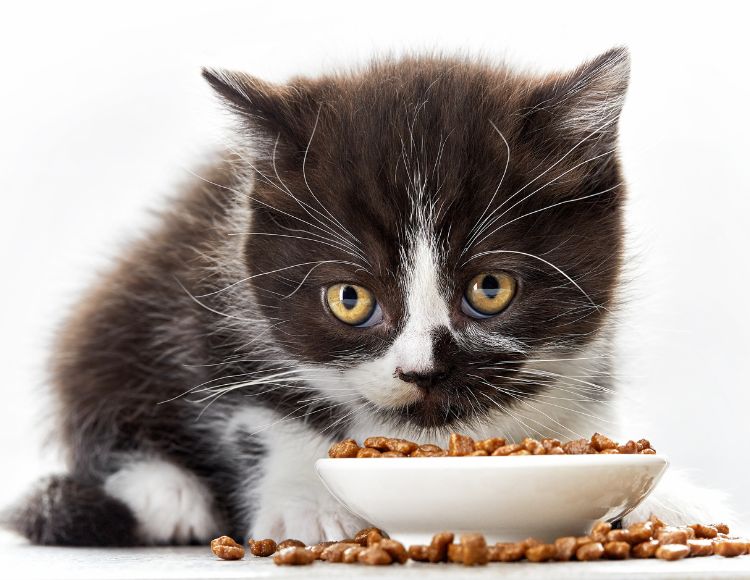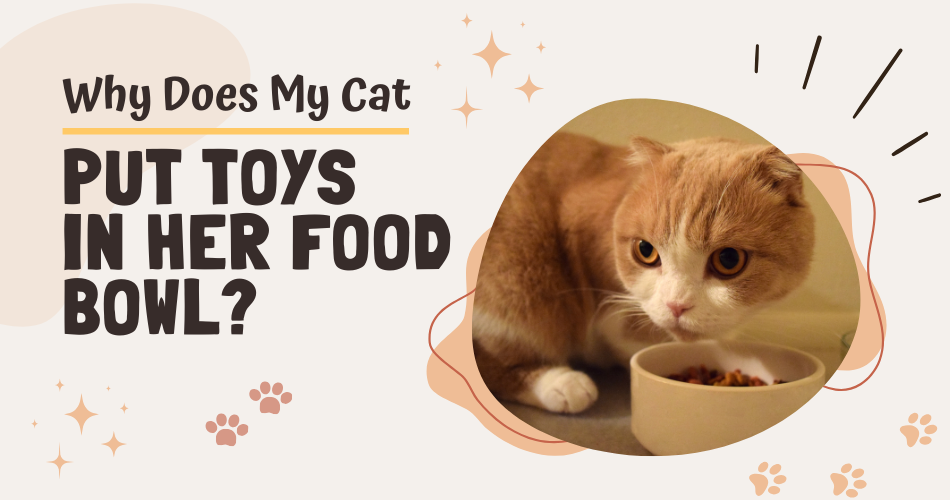Have you ever walked into your kitchen to discover your cat’s toys mysteriously tucked into her food or water bowl? My tabby cat Millie loves to drop her toy mice and balls right into her food. Despite getting some of her fresh, clean toys grimy with kitty kibble crumbs or having to fish soggy toys out of her water fountain, I can’t help but laugh each time I uncover her latest “gift” in her dishes.
In this blog, we’ll explore some theories behind why cats exhibit this playful yet perplexing behavior. We’ll also discuss managing toy deposition in feeding stations while avoiding inadvertently reinforcing attention-seeking or disruptive actions. From insights into the feline mind to simple management tricks, read on to crack the curiosity of cats caching toys among culinary essentials.
Theories Behind the Puzzle of Toy Collection in Food Bowls

Many intriguing theories aim to explain cats concealing playthings in food bowls. One suggests felines relive primal hunting instincts by dropping prey stand-ins among what smells like another recent quarry to them. A pet food diet replaces mice and birds, but the instinct to collect multiple catches in one handy spot remains strong. Their food dish provides a convenient place to gather and “show off”.
Cats also use urine and other scents to mark territory. By leaving toys doused in their scent amid food, your cat mixes olfactory cues identifying the feeding station as “theirs”. They may simply wish to claim ownership of their personal space as clearly as possible.
Another hypothesis points to boredom as an instigating factor. Playful kitties seek entertainment through improvised games when alone for too long. Tucking toys throughout the food bowl prompts you to interact with them upon your return as you extract items before serving dinner. Negative attention still beats no attention in some cats’ minds. As pack animals, most don’t cope well with long spans of solitary time.
Others believe the behavior stems from observation during kittenhood. A mother cat brings dead prey to her babies when teaching them to hunt. Kits first explore these “toys” under her supervision. Your cat may flash back to those early lessons while playing with you. Food dishes simply provide convenient camouflage mimicking a natural forest floor. By hiding playthings in this socially significant context associated with maternal caretaking, cats manufacture bonding opportunities. If your cat leaves Best Paw Balm For Dogs in the bowl, surely with much less macabre intent than their primordial ancestors!
Managing Toy Placement in Food Bowls
If your cat caching toys in his dinner dish doesn’t gross you out, feel free just to let them indulge in this harmless habit. Ensure playthings remain non-toxic to eliminate risks of poisoning. Routinely wash water and food bowls to prevent germ transmission, and use stainless steel, ceramic, or glass to resist scratches harboring bacteria. Pick up damp toys, run them through the dishwasher or hand wash regularly before reuse as well.
You can manage the situation through prevention too. Try placing food mats under bowls to block access. An occasional squirt from a pet-safe water bottle when catching a kitty in the act may deter this behavior. Redirect them to appropriate scratching posts or toys instead while praising and rewarding desirable chewing habits.
Rotate novel toys frequently to refresh curiosity and prevent boredom. Interactive play sessions are ideal before meals as an outlet for hunting drives. Food puzzle games engage your cat’s natural foraging instincts both mentally and physically stimulate as well. Just go slowly if introducing unfamiliar objects underfoot during feeding. This could seem threatening initially.
Above all resist scolding or raising your voice if catching your cat meddling with her food area toys. Remember, positive reinforcement shapes behavior far more effectively long term than punishment. Harsh reactions often backfire by aggravating attention-seeking activity. With patience and vigilance, you can guide your kitty toward more suitable outlets for play and curiosity.
Conclusion
If you ever find your cat’s toys popping up suspiciously amongst their food or water bowls, rest assured this pattern stems from normal feline instincts. Whether claiming territory, alleviating boredom, or craving social interaction, harmless hiding habits mean no trouble. Gently redirecting toy placement combined with ample exercise and affection provides adequate outlets for playful expression.
As always, discuss any concerns over excessive behavioral changes with your veterinarian as well. Medical conditions causing pain, dietary issues, or age-related cognitive decline sometimes manifest through inappropriate elimination or vocalization requiring diagnosis too. Most important of all – make sure to snap some photos capturing those silly moments of finding your cat’s stashes before cleaning up!
Have you ever experienced mysterious toy accumulation in your own cat’s dishes or other surprising places? Share your amusing pet stories and photos with fellow cat lovers out there! Let’s swap tips on smoothly coexisting with and occasionally outwitting our quirky feline friends and their stealthy hiding skills! Thanks so much for reading today. Hope to catch you next time!

